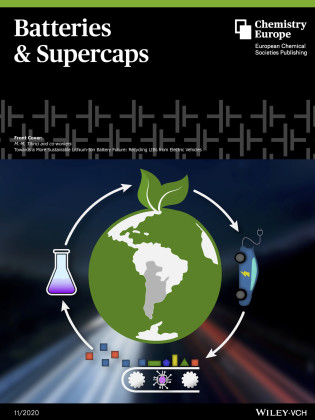Current projects
Recent publications, 2020 - to date
Lander L, Tagnon C, Nguyen-Tien V, Kendrick E, Elliott RJR, Abbott AP, Edge JS, Offer GJ, 2022, Breaking it down: A techno-economic assessment of the impact of battery pack design on disassembly costs, Applied Energy, Vol: 331, 120437
Lander, L, Cleaver, T, Rajaeifar, M.A, Nguyen-Tien, V, Elliott, R.J.R, Heidrich, O, Kendrick, E, Edge, J.S, Offer, G, Financial Viability of Electric Vehicle Lithium-Ion Battery Recycling, iScience 2021, 24, 102787
Lander L, Kallitsis E, Hales A, Edge J.S, Korre A, Offer G, 2021, Cost and carbon footprint reduction of electric vehicle lithium-ion batteries through efficient thermal management, Applied Energy, Vol: 289, Pages: 116737.
Chitre A, Freake D, Lander L, Edge J, Titirici MM, 2020, Towards a More Sustainable Lithium‐Ion Battery Future: Recycling LIBs from Electric Vehicles, Batteries & Supercaps, Vol: 3, Pages: 1 – 12
Our paper featured as a cover page in Batteries & Supercaps
Our paper on a More Sustainable Lithium-Ion Battery Future featured as a cover profile in Batteries & Supercaps - Nov 2020
Chitre A, Freake D, Lander L, Edge J, Titirici MM, 2020, Towards a More Sustainable Lithium‐Ion Battery Future: Recycling LIBs from Electric Vehicles, Batteries & Supercaps, Vol: 3, Pages: 1 – 12
Lithium-ion batteries are a key enabler for environmentally beneficial technologies in both energy and mobility and, consequently, the market for lithium-ion batteries is predicted to grow significantly in the next two decades. However, lithium-ion batteries can only truly deliver on their promise for clean technologies if the sustainability issues in the current battery lifecycle are addressed. There are a number of ways this can be tackled, but it is important to consider each strategy from a whole systems perspective and to identify trade-offs between environmental and battery performance factors. For example, in order to make batteries easier to recycle, it may be necessary to change the materials or the cell and pack configurations to accommodate disassembly and these changes may incur a reduction in energy or power performance. From a whole lifecycle cost perspective, this reduction may be acceptable, but identifying the factors and their breakeven points requires more research. At present, the environmental impact of battery improvements is rarely taken into account and more work is needed to incorporate sustainability factors into cell design.

